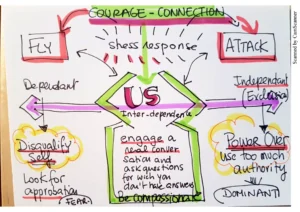There are sentences that burn. Words you can feel coming, but that strike anyway. Like a storm: suddenly, your whole nervous system goes on alert. How do you turn your inner storm into a leadership force?
A director I work with recently confided in me:
“I was stung to the core when a colleague said to me, “Anyway, you don’t have the skills to do that, do you?” It was a provocation, I knew it… but it hurt.
Who hasn’t experienced that? An acid remark, a condescending tone, a subtle dig – and suddenly, your body reacts before your head.Your heart speeds up, your jaw clenches. Your nervous system, programmed to protect you, chooses one of three options: attack, flee or freeze.
When tension tests our individual power
When faced with tension, we don’t all react in the same way.
Some flee, others counter-attack. Some shut down, others try to stay connected.
And then there are those who, over time, learn to stay present.
If I wasn’t careful, I was clearly the type to counter-attack. And not just half-heartedly: pressing hard, poking where it hurt.
I’ve learned to recognize this reflex, to understand where it came from: from that little kid nobody listened to, who had come to believe that to exist, you had to assert yourself more than the others.
Our reactions don’t just tell us something about our temperament; they reveal our relationship to relational power.
When a word destabilizes us, it’s often because it touches a sensitive area: a doubt, a need for recognition, a reflex for legitimacy.
It’s not a weakness: it’s neurobiology. Under stress, the amygdala takes control. The rational cortex goes on standby. We react, not respond.
But tension, if we look at it closely, is an opportunity. It tests our antifragile leadership, our ability to stay connected without denying ourselves.
The continuum of relational power
Over the years, I’ve observed that our behaviors in tense situations are part of a continuum:
On the left: emotional dependence, where we seek approval, even if it means disqualifying ourselves.
On the right:defensive independence, where you protect yourself behind control or authority.
And at the heart of it all:interdependence, the space of we, where power becomes relational rather than hierarchical.

It’s in this space of the ” we” that the most subtle posture develops – the one where we can hold our place without crushing, listen without erasing ourselves.
And it’s precisely here that authentic assertiveness takes root.
My definition of assertiveness
I’m often asked for coaching to “reinforce assertiveness”, as if this meant learning how to impose oneself or gain respect, especially in the managing disagreements, tensions and conflicts.
But for me, assertiveness has nothing to do with domination: it’s an inner posture.
It’s a way of inhabiting relationships by remaining anchored in one’s truth, without trying to convince or please.
Being assertive means standing up straight in the link:
– clear about how you feel,
– clear about what you need,
– open to others without denying yourself.
In this space of interdependence, each party acknowledges the other’s emotion without dissolving into it, while expressing its own without projecting it.
I can say:
“I understand what you’re feeling, I see what I’m causing, I recognize it, and this is what I need, even if it’s different.
”
This is authentic assertiveness: the kind that keeps the connection alive while maintaining the clear boundary.
And this is where the essential nuance between sympathy and empathy appears.
- Sympathy lets us slip into the other person’s emotions – we dive in with them.
- Empathy enables us to understand without absorbing, to see and name without losing ourselves.
True assertiveness is rooted in the quiet clarity of women who no longer need to impose themselves in order to be heard, nor to remain silent in order to be accepted. It’s a skill of balance. A posture of conscious, anti-fragile leadership, because it transforms tension into learning, disagreement into a space for clarification, and every difficult exchange into an opportunity for growth – for oneself and for the relationship.
Become aware of your attachment pattern
John Bowlby, founder of attachment theory, showed that the way we enter into relationships is constructed very early on, through our first experiences of security – or insecurity – in childhood. Mary Ainsworth later confirmed and clarified these observations, identifying different modes of bond regulation.
- Some people develop anxious attachment: they fear the loss of the bond and constantly seek validation – a survival pattern very common in women.
- Others show an avoidant attachment: they prefer to keep their distance so as not to depend on anyone – the Amazon pattern of needing no one.
- Finally, there is a secure or healthy attachment, a rare balance where we can be close without losing ourselves, autonomous without cutting ourselves off.
More recent research, notably byAmir Levine and Rachel Heller(Attached – The New Science of Attachment, 2010/2019), has shown that these dynamics do not only concern the intimate sphere.
They also influence our behavior in the workplace: need for approval, fear of rejection, difficulty in setting limits or trusting.
Recognizing them is already the first step towards greater relational maturity and conscious power.
The keys to interdependence
That’s what interdependence is all about. Neither fusion nor domination. A posture of balance and awareness, where I remain connected while remaining free. A posture at the root of conscious leadership: the ability to hold one’s place without crushing, to listen without fading away.
From fragility to relational antifragility
Back to my client. She knew her colleague’s sentence was a provocation.
But the bite was real.
“What hurt you more: the sentence, or what it awakened in you?”She pondered, “The feeling that he might be right.”
That’s the tipping point. Antifragility begins when you’re willing to look at what hurts without running away.
She could have retorted curtly:
“And you, are you qualified to judge me?” – attack reflex.
Or keep quiet and ruminate all day – flight reflex.
But the antifragile posture consists of putting the ball back in the center without violence, but with awareness:
“Interesting that you think that. What makes you think I couldn’t?”
This response keeps the link open while shifting the power relationship.
It transforms tension into useful feedback. That’s whatrelational antifragility is all about: not “staying zen”, but growing with every jolt.
According to Nassim Nicholas Taleb, in Antifragile: Things That Gain from Disorder, antifragility doesn’t just resist: it takes advantage of the shock to strengthen itself.
Applied to conscious communication, it’s the ability to transform conflict into clarity, emotion into learning.
Leadership as a laboratory for antifragility
In leadership, tension is not an anomaly: it’s the training ground.
Every disagreement, every silence, every uncomfortable emotion is an opportunity to hone our skills. our awareness of power.
The challenge is not to avoid these moments, but to learn how to get through them without betraying ourselves.
To understand that tension, properly experienced, is a form of feedback.
She talks about how to listen, how to set limits, how to strike the right balance between influence and openness.
Without feedback, how can we evolve? How can we hone our lucidity, discernment and presence?
As Brené Brown says in Dare to Lead:
”
Choose courage over comfort”
And it’s this choice, repeated again and again, that makes us antifragile.
To remember
To manage tension is to manage power – your own, the other person’s, and the relationship’s.
And the more you dare to cross it without fleeing or crushing, the more you become
True strength comes from the ability to turn every tension into learning, to choose courage over comfort, and to stay alive, aware and connected, even when the storm is roaring.
Resources that really inspired me
- Daniel J. Siegel – L’esprit en développement (Éditions De Boeck, 2015) – which I’ve read and listened to at least three times!
A fascinating book for understanding how relational experiences shape our brains, emotions and reactions. Siegel shows how to link reason and emotion to develop conscious communication and aligned presence – the bedrock of antifragile leadership. - Amir Levine & Rachel Heller – Attached (Éditions Marabout, 2019).
This book is a fascinating gateway to the psychology of adult attachment. In it, the authors describe three profiles that influence the way we enter into relationships. - Brené Brown – Dare to Lead (Guy Trédaniel Éditeur, 2019).
A must-read for exploring relational courage, vulnerability and authentic assertiveness. Brown reminds us that true leadership is not about pleasing, but about daring courage rather than comfort. - Nassim Nicholas Taleb – Antifragile: Les bienfaits du désordre (Les Belles Lettres, 2013).
An essential essay for understanding how shocks, tensions and uncertainty fuel our evolution. Taleb shows that true solidity comes from movement and the ability to learn from shocks.
Do you want to explore how to transform disagreements and conflicts into lucid power, develop your antifragile leadership and more conscious communication?
Discover my women’s leadership coaching programs here.
Also check out my short online course here.








